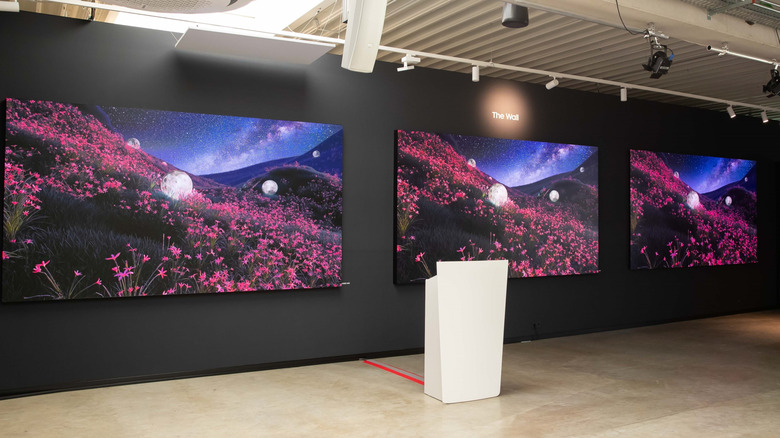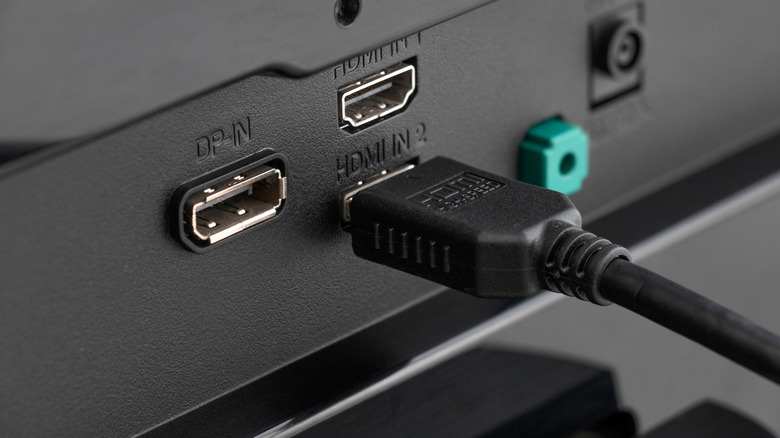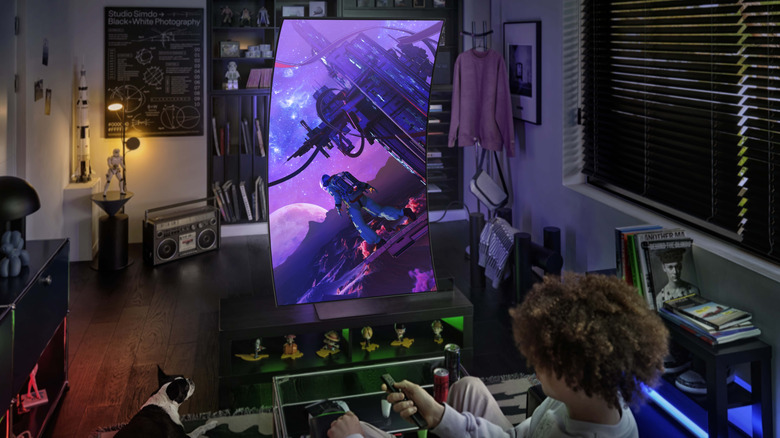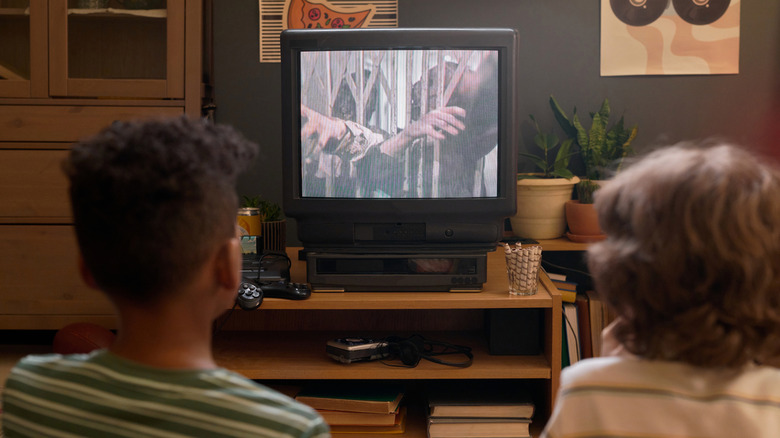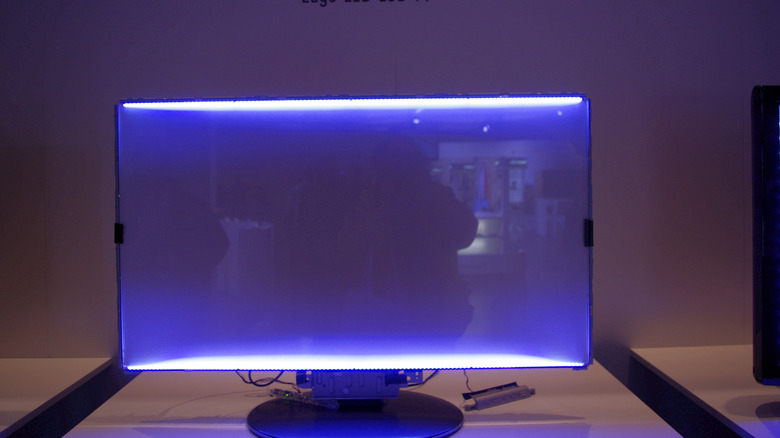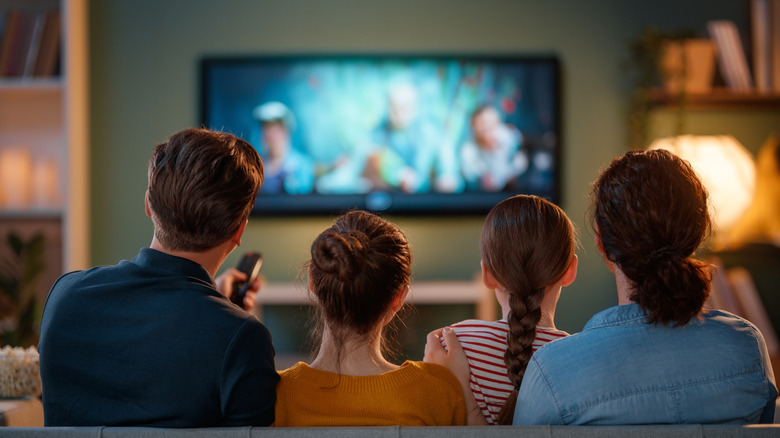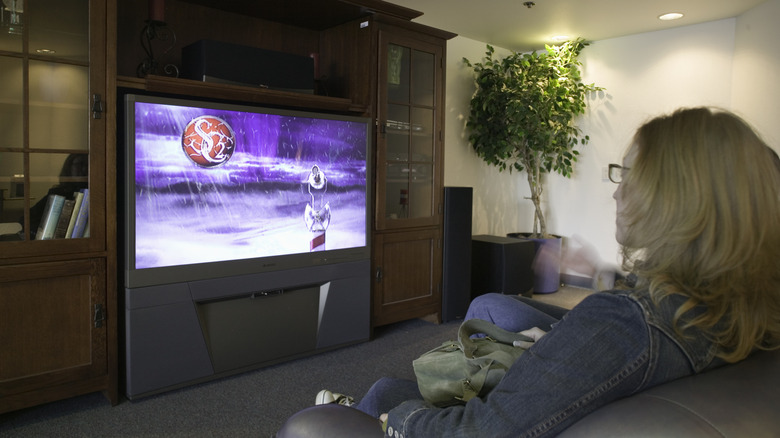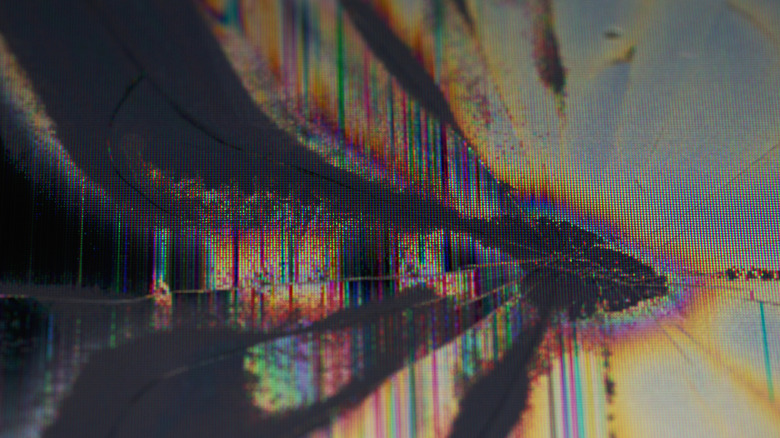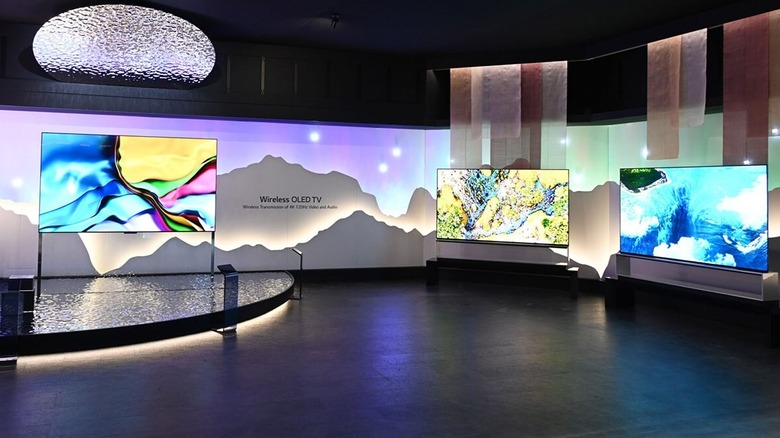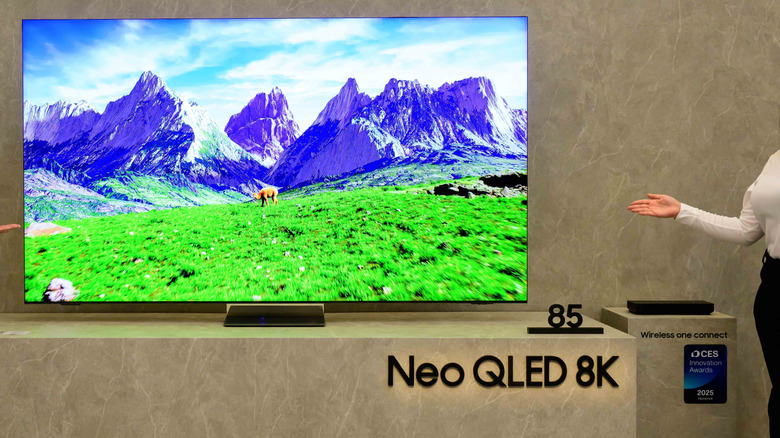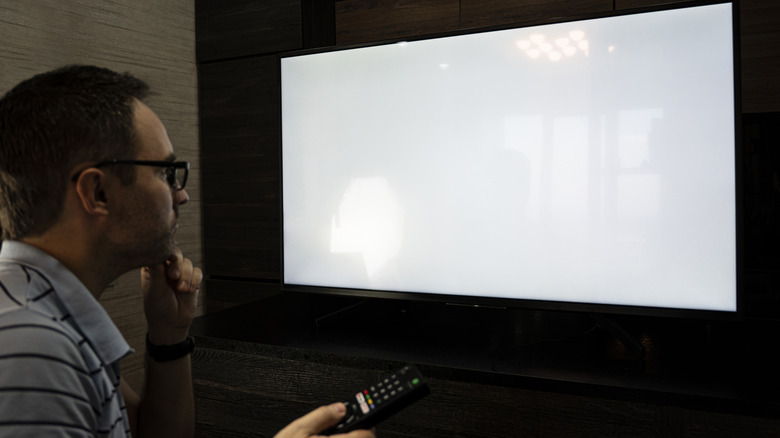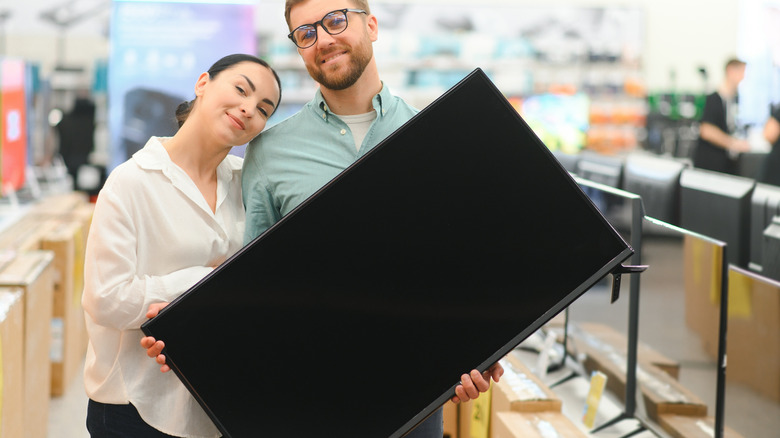13 Types Of Used TV You Might Want To Avoid Buying Used
The used television market can look very appealing, especially when you get to snag those awesome features and bigger screen sizes for far less than what a brand-new set would cost. With tech moving so fast and new models popping up all the time, many perfectly good TVs end up on the secondhand market. That's great for anyone who wants to save some cash. However, while some used electronics are definitely "hidden gems," buying a used TV comes with a big risk. Modern electronics are intricate beasts with a finite lifespan, and the components start to degrade over time.
Consequently, the real value of a secondhand television isn't just about how it looks and whether it currently works. It's dictated by its history, internal architecture, long-term compatibility, and the high financial risk you take on if you need to repair components when they inevitably fail. This article is going to dive into some common pitfalls of the used TV market, detailing specific types of televisions that you should seriously think about avoiding entirely, in favor of a new model that comes with a full warranty.
Refurbished TVs with unknown repair history
Generally speaking, picking up a refurbished TV with a totally unknown repair history just isn't worth the risk when you could just buy a new one, or at least a properly certified refurbished unit. "Refurbished" usually means a manufacturer or big retailer has professionally restored a product to be basically like-new, and it comes with a warranty. Meanwhile, when you get a used TV from some private seller or an uncertified place, you're buying it as-is. That means the condition is a total toss-up, and you almost certainly won't have a warranty or return options if something goes wrong.
The big worry here is that any issues with a used TV that's had dodgy repairs might have just been patched up with cheap, unofficial parts. That'll severely cut down its lifespan and probably lead to those annoying, recurring faults. If the fix was simple and inexpensive, the seller would've probably just done it themselves. That would suggest the current problem is either expensive to sort out or points to something much deeper. It's just better to get refurbished models from trusted companies, rather than secondhand places like the Facebook Marketplace or a relatively unknown seller on eBay.
TVs lacking current-gen HDMI ports
Picking up a used TV that only has older ports, like HDMI 1.4 or earlier, probably isn't worth your money, at least if you're looking for a 4K TV. You're just setting yourself up for some serious compatibility headaches, and it'll dramatically limit what you can actually do with all your newer gear and the latest content. If you don't know much about what HDMI or the number means, what's important is that HDMI 1.4 is its limited 10.2 Gbps bandwidth. Sure, it was the first to technically support 4K resolution, but that was a huge restriction since it was capped at a measly 30Hz refresh rate. That slow refresh is definitely not good for gaming, and you'll see noticeable blurring and choppiness during anything fast-moving, like sports.
Those older HDMI 1.4 TVs also miss out on High Dynamic Range (HDR), which is a key feature that became the standard with HDMI 2.0a and the newer versions. HDR makes a huge difference in picture quality, giving you a much wider color gamut and greater contrast with those nice, deep blacks and brighter whites. Finally, next-gen gaming consoles, like the PS5 and Xbox Series X and S, need HDMI 2.1 to unlock their high-performance modes, like 4K at 120Hz, plus Variable Refresh Rate and Auto Low Latency Mode.
Older curved screen TVs
Older curved screen TVs generally aren't a smart buy on the used market, in part because the tech is just not worth it. The core issue with curved TVs is that the sweet spot is severely limited. You only get the supposed benefits, like that immersive feeling and better picture depth, if you're sitting dead center and close to the screen. The minute you move to the sides, the picture starts to look unnatural, you get weird distortion, and the colors can get reduced. That makes older curved TVs a pretty terrible fit for shared or group viewing in a standard living room. It's also hard to correctly clean a curved TV if you don't know what you're doing.
On the other hand, that curve also tends to magnify and distort reflections from windows or lights across a bigger chunk of the screen, which can frequently make the glare unbearable, depending on your room. Since manufacturers don't make as many curved TVs as they used to, used models carry some serious age-related and practical risks. If an older curved TV breaks down, finding replacement parts can be a real headache, since they're just not available in the market anymore. That would mean that if the screen or panel starts having problems, the repair cost may not be worth it.
TVs from manufacturers no longer active in your region
Buying a used TV from a manufacturer that's completely checked out of your area just isn't worth the money or the headache. This means brands like RCA, Westinghouse, Sanyo, Magnavox, or some of the older Hitachi and JVC sets. If the company has stopped making TVs or totally bailed on markets like the US or UK, you're stuck with a device that has zero support. The absence of a manufacturer means that if the TV needs a repair, you can't get official technical support or service.
A huge issue with these older models is the complete loss of firmware and software support, which is absolutely critical for any modern "smart" TV. Most smart TV operating systems need regular updates to keep them running well and, most importantly, safely. Manufacturers typically keep pushing updates for four to seven years. If the TV's maker is inactive in your region, those smart features will eventually stop getting security patches and updates. This leads to frustrating compatibility issues with your favorite streaming services and apps. At that point, your fancy smart TV is effectively just a "dumb" display, and you're forced to buy an external streaming stick, like a Roku or Apple TV, just to get the functionality back.
LCD TVs with edge-lit backlighting
You should generally steer clear of buying used LCD TVs that use edge-lit backlighting because that design has huge durability problems that are basically guaranteed to show up as annoying picture quality issues over time. Unlike TVs that are direct-lit or have Full Array Local Dimming, which spread the LEDs all across the back of the set, edge-lit TVs jam those LED strips only around the perimeter, and often only along the bottom. Sure, this lets companies make super-thin TVs, but it forces all the heat to pile up in that small area.
That concentrated heat is why you see the most common failures in secondhand edge-lit models. When you crank the TV up to max brightness, those LEDs can hit high temperatures, like 253 degrees Fahrenheit, which quickly leads to them burning out and degrading. On top of that, the intense heat can warp the reflector sheets inside the TV. These built-in design flaws mean that used edge-lit TVs are very likely to develop picture flaws like clouding or light bleed, which are those uneven bright patches. If you want better durability and performance, you're much better off going with a Full-Array Local Dimming or a direct-lit model.
TVs with very low native refresh rates
If you're looking at used TVs for something like gaming or high-action content, true 60Hz or 50Hz just aren't worth the money. They simply can't keep up with what we watch and play today, and you're going to see a bunch of visual flaws that make the whole experience subpar. While 60Hz is fine for just watching your standard TV fare, it's seriously insufficient for getting the smooth motion clarity you need in fast-paced stuff like live sports and gaming. Of course, a high refresh rate TV is only useful when it's being fed high frame rate content. You may not know that the refresh rate affects picture quality in some ways. In this case, fast-moving objects on a 60Hz LCD screen are prone to looking blurry or jittery due to motion blur.
For gamers, that low native refresh rate is a huge dealbreaker because it completely locks you out of modern performance features. The Xbox Series X and S and PS5 require a native 120Hz refresh rate to unlock features like 4K at 120 fps, which can make for a much more responsive gaming experience. You also have to beware of misleading marketing terms like "120 Motion Rate" or "Effective Refresh Rate." These terms try to imply a high refresh rate, but are really a native 60Hz panel using processing tricks like black frame rate manipulation to simulate smoother motion.
Projector TVs (rear-projection)
Used rear-projection TVs (RPTVs), especially the older rear-projection models, are generally not worth buying. They're built on ancient, obsolete tech that basically guarantees you'll be dealing with big maintenance costs and picture quality that's awful compared to what we have now. Given that RPTV tech has been largely superseded since the late 2000s and early 2010s, grabbing one used means you're buying an obsolete device that is highly prone to failure and difficult to repair due to complexity and lack of parts.
The early CRT-based RPTVs, for example, often had an image that was dim, fuzzy, and washed-out. Even in a dark room, they were way inferior in sharpness and brightness to a standard CRT television of the time. Also, these TVs have a really narrow viewing angle. If you're not sitting straight in front of the screen, the picture quality degrades and looks unevenly lit. These projector TVs also have significant and costly maintenance requirements. If you've got a DLP model, you can expect to replace the projection lamp/bulb periodically. That'll cost you somewhere around $100, and it only really lasts a few years with regular use.
TVs with visible dead pixels or stuck pixels
TVs with visible dead pixels or stuck pixels are generally a terrible idea to buy used, even at a discount. A dead pixel is a tiny black or white dot that's completely unlit; It's not getting any power, which signals a permanent hardware failure. Some dead pixels can be fixed because they are actually stuck pixels, while truly dead pixels are permanent and won't respond to any fix. You might be able to treat stuck pixels with software tools or risky manual methods like gently applying pressure, which can cause new damage or void the warranty.
A stuck pixel, unlike a dead one, is frozen on a single color (like red, green, or blue) because some of its subpixels are always on. The main problem is that dead pixels can't really be repaired or brought back to life. The only sure-fire fix is replacing the entire display panel, and to be clear, that's often so expensive it might as well be the cost of a brand-new TV.
Even just one dead or stuck pixel can be incredibly distracting. Once you notice that defect, it's hard to "unsee" it. Your eye will just keep going back to it, especially during dark scenes or when you're watching content with a solid color background.
High-use, ex-commercial, and ex-display models
Buying a secondhand TV that was used for commercial and public display purposes is not worth the trouble. The main reason is that all those demanding operational hours severely accelerate hardware degradation, and they might even void the warranty. Most consumer TVs are actually only designed for the limited daily use that you would expect at home. When these TVs get used commercially, like for a retail display, in an airport, or at a sports bar, they're often running non-stop for 12 hours a day, seven days a week, or sometimes even 24/7.
This heavy usage is what significantly shortens the remaining lifespan of the television. Here's the kicker: Manufacturers' warranties are usually voided the second a consumer TV is used in a commercial environment, or they get reduced to shorter duration. This means the buyer is essentially getting a damaged product with virtually no financial protection. Store display models are also frequently run in bright settings. Running a TV at maximum brightness generates high levels of concentrated heat, which quickly burns out the LED backlights on LCD/LED models, and that often causes visual problems like fading, uneven brightness, or hotspots.
High-end TVs that require a One Connect Box
Older high-end TVs that rely on the separate One Connect Box by Samsung are just generally not worth picking up used. It all comes down to the huge risk of a complete and total failure centered on that proprietary box, and the fact that finding a replacement is almost impossible. The One Connect Box is where all your external inputs live, and it transmits power and data to the display panel using a single, incredibly delicate cable. If that box or its special cable get lost or damaged, the entire television becomes unusable.
A critical downside here is just how hard and pricey it is to replace this essential bit of hardware. Samsung usually stops making these One Connect Boxes after just a few years, which means trying to track down the right box and cable for an older model is either difficult or downright impossible on the secondhand market. They're not as expensive as a new TV, but paying over $100 just to get a used TV to work isn't a very fun deal. This kind of defeats the purpose of buying used in the first place. You need to be super careful because the One Connect Box model must match the specific TV model; They're generally not interchangeable across different TV models or years because of those proprietary protocols and cable requirements.
LED/LCD TVs with dimming or flickering backlights
When you're checking out used LED/LCD TVs, it's usually a bad idea to go for one that's already dimming or flickering. These visible problems are basically huge red flags that point to some serious hardware issues that are going to be tough to fix, especially since you won't have a warranty.
Things like flickering, dimming, or just plain uneven brightness are the classic signs of a failing backlight system. This can even look like the screen is totally black, while you can still hear the sound. If the screen briefly lights up and then goes blank, that often suggests a problem with the inverter or the circuit board. This kind of instability usually comes down to critical component failures, like a bad power supply board or some faulty capacitors.
The big risk here is the incredibly short lifespan you're buying into and how much harder the repair will be. If the previous owner constantly ran the TV at max brightness, the lifespan is severely shortened. What's worse is that because the LED strips are often wired in series, the failure of just one LED can cause the whole system to freak out or go dark.
Early generation 8K TVs
Early generation 8K TVs were an immature tech push into a format that still doesn't have much content. Those first 8K sets were expensive when they first came out. Buying one used now means you're paying for a premium feature that's still basically unusable years later because there's a lack of native 8K content out there from streaming, Hollywood, or even the gaming world.
Since native content is pretty much nonexistent, these TVs have to upscale almost everything, even your 4K and 1080p sources. This is often pointless and can actually mess up or degrade the original image quality instead of making it better. Resolution isn't the main thing that dictates picture quality anymore; Modern features like HDR capabilities and contrast are far more important. In fact, an affordable, modern 4K OLED TV offers significantly better picture quality than those older, expensive 8K LCD models.
The lack of longevity and repair support is what really kills the used value here. The risk of component failure is even worse because manufacturers, who launched the tech way too early, have often stopped making the proprietary replacement parts, like the main board.
Plasma TVs
You should generally skip buying a used Plasma TV because the technology is just ancient at this point. Manufacturers stopped making Plasma TVs around 2015, which means even the newest ones you'll find used are already a decade old. While we all loved the picture quality back in the day, they're completely outclassed now. You're capped at a 1080p resolution, and they totally miss out on modern standards like High Dynamic Range. A massive design flaw is how easily they suffer from permanent image burn-in. Leave a static image like a news ticker or a game's HUD on for too long, and those phosphors will wear unevenly, leaving a ghost image that you just can't fix.
Plasma TVs are also notorious energy hogs, sucking down way more power than today's LCD or LED models. All that energy use generates a ton of heat, and that overheating really stresses the internal parts. Failures usually come from faulty components like the power supply board or the capacitors. Since these sets are discontinued, trying to find genuine replacement parts for big failures like a panel or a main board is often difficult or totally impossible. Unfortunately, plasma TVs just ended up being a futuristic idea that totally flopped, but we live and learn.
